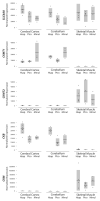Comparative expression analysis of the phosphocreatine circuit in extant primates: Implications for human brain evolution
- PMID: 21190724
- PMCID: PMC4136512
- DOI: 10.1016/j.jhevol.2010.10.004
Comparative expression analysis of the phosphocreatine circuit in extant primates: Implications for human brain evolution
Abstract
While the hominid fossil record clearly shows that brain size has rapidly expanded over the last ~2.5 M.yr. the forces driving this change remain unclear. One popular hypothesis proposes that metabolic adaptations in response to dietary shifts supported greater encephalization in humans. An increase in meat consumption distinguishes the human diet from that of other great apes. Creatine, an essential metabolite for energy homeostasis in muscle and brain tissue, is abundant in meat and was likely ingested in higher quantities during human origins. Five phosphocreatine circuit proteins help regulate creatine utilization within energy demanding cells. We compared the expression of all five phosphocreatine circuit genes in cerebral cortex, cerebellum, and skeletal muscle tissue for humans, chimpanzees, and rhesus macaques. Strikingly, SLC6A8 and CKB transcript levels are higher in the human brain, which should increase energy availability and turnover compared to non-human primates. Combined with other well-documented differences between humans and non-human primates, this allocation of energy to the cerebral cortex and cerebellum may be important in supporting the increased metabolic demands of the human brain.
Copyright © 2010 Elsevier Ltd. All rights reserved.
Figures


References
-
- Aiello LC, Wheeler P. The expensive-tissue hypothesis: the brain and the digestive system in human and primate evolution. Curr. Anthropol. 1995;36:199–221.
-
- Brosnan JT, Brosnan ME. Creatine: endogenous metabolite, dietary, and therapeutic supplement. A. Rev. Nutr. 2007;27:241–261. - PubMed
Publication types
MeSH terms
Substances
Grants and funding
LinkOut - more resources
Full Text Sources
Research Materials
Miscellaneous
